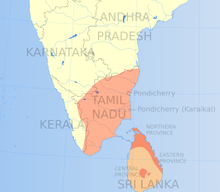Myanmar Tamils
| Part of a series on |
| Tamils |
|---|
 |
Myanmar Tamils or Burmese Tamils are people of ethnic Tamil ancestry who reside in Myanmar. Tamils had the earliest contact with Myanmar during the first-second century CE.[1] The Tamil Chola empire had trade relationships with various Burmese kingdoms.[2] The large Tamil migration to Myanmar began during the British colonial era. Tamils worked as labourers in rice fields and rubber plantations. According to a report from 1966, there were 200,000 Tamils in Myanmar.[3] Since the Second World War, the number of Tamils has declined dramatically and many fled back to India and other countries. The Burma Bazaar in Tamil Nadu was set up in 1969 by Myanmar Tamil refugees.
Between 1940 and 1942 many Malaysian and Myanmar Tamils were forced by Japanese occupiers to labour on a 415 km railway track between Thailand and Burma. Over 150,000 Tamils died during the project by poisonous animals, illnesses, exhaustion and Japanese torture.[4]
Majority of the Tamils in Myanmar are Hindus and there are Tamil Hindu temples in Yangon. Many Myanmar Tamils have a Burmese name or don't speak Tamil, but they work to preserve their Tamil identity. Tamil community sometimes faces discrimination in Myanmar but less than other ethnic groups like the Rohingya people.[5]
See also
References
- ↑ Historical Dictionary of the Tamils (2007), Vijaya Ramaswamy, 258p.
- ↑ My Myanmar Years: A Diplomat’s Account of India’s Relations with the Region (2015), Preet Malik, 3 introduction
- ↑ Historical Dictionary of the Tamils (2007), Vijaya Ramaswamy, 258p.
- ↑ "The real Kwai killed over 1.50 lakh Tamils". The Hindu. 27 August 2016. Retrieved 30 January 2017. Retrieved 30 January 2017
- ↑ "Myanmar's Tamil community works to maintain their culture". Mizzima.com. 13 February 2016. Retrieved 30 January 2017. Retrieved 30 January 2017